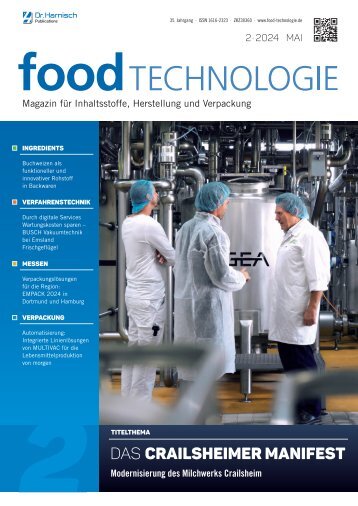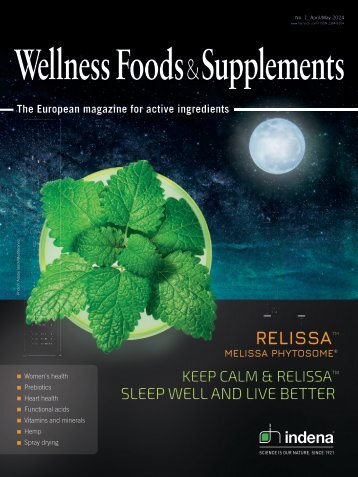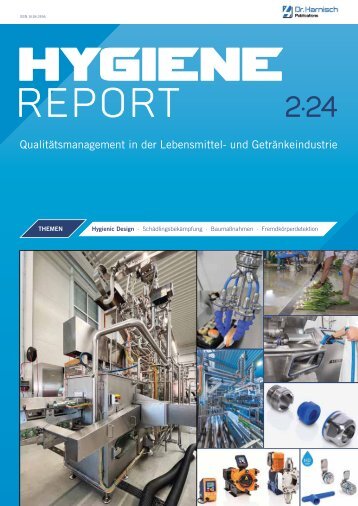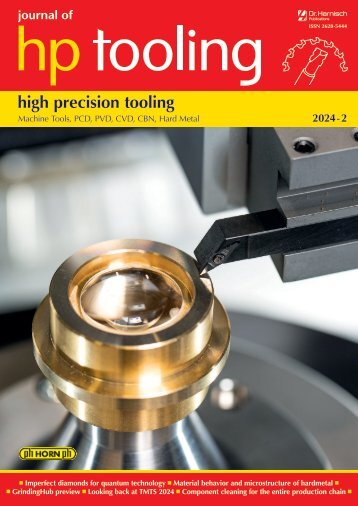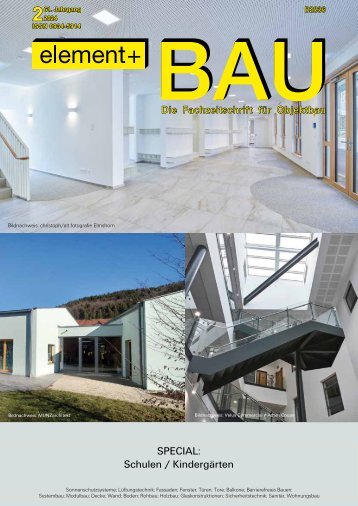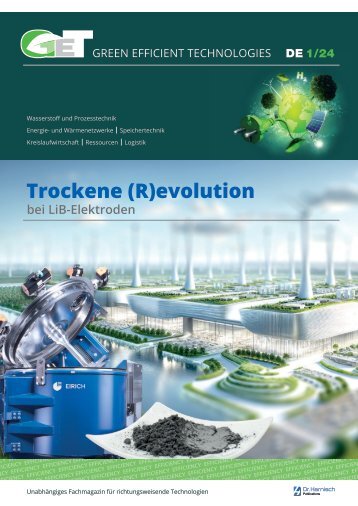GET – GREEN EFFICIENT TECHNOLOGIES – English Language
- Text
- Harnischcom
- Materials
- Valve
- Electricity
- Grid
- Valves
- Technologies
- Efficient
- Pumps
- Hydrogen
- Efficiency
Companies - Innovations
Companies - Innovations - Products Fig. 3: Flexible applicable pump unit as container design A second example from the field of new, climate-friendly energy sources is the production of biodiesel: a fuel with many challenges. High-pressure pumps make an essential contribution towards the production of these environmentally friendly fuels. Biodiesel or fatty acid methyl ester (FAME) is a fuel that is equivalent in use to mineral diesel fuel. The chemical industry obtains biodiesel by transesterifying vegetable or animal fats and oils with monohydric alcohols such as methanol or ethanol. During production, the fatty acids contained in the oil are split off from the glycerol with the aid of a catalyst and chemically converted with methanol, i. e. esterified. In various steps, this process produces the fuel “biodiesel” as the main product and the by-product “glycerol”, which is used as a food additive and in medicine. The methanol is recycled back into the reactor. In today's industrial, patented processes, so-called supercritical processes, various reactions take place simultaneously and within a few minutes. They achieve maximum yield and, thanks to the special process parameters, no longer require catalysts. For this purpose, high-pressure pumps are used to pump methanol and fatty acids against high pressures. Depending on the production plant, pump capacities of up to several hundred kilowatts are required for these applications. The particular challenges for the high-pressure pumps lie in the properties of the pumped media: methanol, for example, has hardly any lubricating properties, while other media tend to crystallize early, which can severely disrupt pump operation and lead to reduced service lives. Local conditions, such as use in hazardous areas or particularly high or low temperatures, also place enormous challenges on the pump units and thus on their manufacturers. Compliance with local regulations, standards and certificates round off the requirement profile for the pump supplier. Fig. 4: High-pressure pump unit for conveying supercritical CO 2 for extraction The many years of experience, the high level of expertise and the design refinements therefore characterize the robust and long-lasting pumps from URACA to the satisfaction of the customers. Other examples in the field of liquefied gas include CO 2 extraction and the injection of CO 2 into reservoirs. In the extraction of active and valuable substances, aromatic and flavouring substances, the food and pharmaceutical industry is forced to make high demands concerning quality and economy of the extraction process. The CO 2 -method is therefore preferably used in the extraction of primary vegetable products. The optimal sequence of the process depends on the quality and the controllability of process data in the high-pressure section. Efficient industrial utilization of this method requires high reliability and functionality of the most important technical system components. The pumps for increasing the pressure of the liquid CO 2 therefore play a key role in the process, because these pumps can be reliably adapted to the CO 2 -conditions. The main advantages of extraction with the help of CO 2 are, on the one hand, the gentle treatment of the substances and, on the other hand, the cleanliness of the end product, i.e. extracts do not contain any solvent residues. Apart from this, the method enables high selectivity of the extraction. By using suitable process parameters (pressure and temperature), even different active substances can be extracted from the same raw material. This property of CO 2 demands that the parameters process pressure, process temperature and flow volume of the extraction system are maintained almost exactly at a level that matches the required nominal values. Fig. 5: Electrically driven pump unit for the production of biodiesel Pressure generation and volumetric flow control is preferably accomplished by a positive displacement pump, which is able to meet the high demands concerning controllability and constant flow volume and can therefore be very well adapted to the properties of CO 2 . By minimizing the dead space, an oscillating positive displacement pump is able to achieve a very good volumetric efficiency, despite the high compressibility of liquid carbon dioxide. Due to the high process pressures and the relatively low flow volumes, this pump type is particularly suitable for CO 2 -extraction. Positive displacement pumps therefore are the only pump type, which, in combination with a good rate of efficiency, achieve the demanded process data and guarantee exact compliance with the parameters most economically. This stability results from the excellent proportionality of rotary speed and flow volume and its almost complete independence from the process pressure. 50 GREEN EFFICIENT TECHNOLOGIES 2022
Companies - Innovations - Products The following requirements concerning the rating of the pump, which is intended to deliver the CO 2 for the extraction process, must be met. The pump must first be compressed to the required supercritical pressure to be able to transform the CO 2 into the supercritical condition. Compared with water, liquid carbon dioxide has a considerably higher compressibility. Density value essential for the flow quantity (suction and pressure side) can be taken from the table of thermodynamic state variables. Special attention must additionally be paid to the requirements concerning high durability of components and cavitation free delivery at a high overall efficiency of the pump. High demands are thereby placed on sealing of the plunger and the leak tightness of suction and pressure valves. The requirements on fluid contacting parts can only be met by highly specialized designs in connection with the use of special materials. The only standard element of such a pump is the power end with crosshead and crank drive. It is precisely these properties that also predestine the high-pressure pumps for injecting CO 2 into underground reservoirs. With an increasing variety of applications and growing requirements, the development of new products is of elementary importance. Based on this motivation, URACA has added compact pumps to the power ranges of 700 kW and 1200 kW with the two new pump types P3-85 and P5-85 and created a new pump series in the upper range. Key data at a glance: P3-85 P5-85 Power P max 700 kW 1,200 kW Stroke 100 mm Rod load 280 kN Flow rates up to approx. 2,100 l/min 3,500 l/min Gearbox integrated or with long shaft Decades of experience in the development and construction of highpressure plunger pumps, state-of-the-art technology and highest manufacturing quality with maximum vertical integration have made URACA a leading company in the industry. The newly developed highpressure pumps are continuing this successful course. In petrochemical production, specifically in the cracking processes, the central building blocks of a refinery, the basic products for the production of fuels, colors and plastics, pharmaceuticals, detergents, and many other products are produced. The pumps used in these applications demand the highest expectations in design and features. They not only need to operate under high pressures, they also need to operate under high temperatures while providing maximum reliability and durability. Various procedures can be used to process residual oil, which is accrued after refining heavy oil, bitumen or normal crude oil. It is then compressed to around 150-250 bar, mixed with hydrogen and fed into the hydrogenation reactor at up to 450°C. This critical process uses pure hydrogen, so system failure, particularly in the feed pumps is not acceptable. Otherwise, extremely critical operating conditions may arise. As a result, redundant solutions with standby capacity for the pumps are usually used. When in use, each pump is also monitored with adapted instrumentation to detect possible faults early and react to them accordingly, so that it does not become a hazardous situation. Fig. 6: Plunger pump P5-85 for the process industry This adds two extremely compact plunger pumps to the product portfolio, the main features of which are their short design as well as the integrated gearbox. With a stroke of 100 mm and a rod load of 280 kN, the average piston speed can be kept relatively low. The Px-85 series enables an increase in performance compared to long-stroke machines of corresponding performance classes while at the same time complying with the API 674 limitation on average piston speed. The short design, the elimination of external gears and the simultan eous optimization of performance with respect to comparable gearless types enormously expand the range of applications to the benefit of the user. As a result, not only can several pumps be replaced by one in individual cases, the new series also opens up areas of application that previously had to be served by long-stroke and very slow-running types. In addition to saving space, these possibilities also lead to a reduction in costs compared to the complete ensemble with gearbox, converter and similar additional units. Fig. 7: High-pressure plunger pump P3-70 for hot oil Oil as a pumped medium is usually non-problematic and easy to handle. However, residual oil may contain a number of aggressive and corrosive elements. Hydrogen sulphide and sulphur (particularly at high temperatures) are the worst culprits here. At moderate temperatures, sulphur still possesses positive properties in terms of lubricity between the plunger and mechanical seal. But at high temperatures, it behaves in a negative way and can cause heavy corrosion. Sulphur attacks metallic materials that come into contact with the pumped medium here. The challenge for pump suppliers is in choosing and using high-quality alloys to prevent corrosion. GREEN EFFICIENT TECHNOLOGIES 2022 51
- Seite 1 und 2: GREEN EFFICIENT TECHNOLOGIES 2022 H
- Seite 3 und 4: Editorial Hydrogen in the atmospher
- Seite 5 und 6: HAMPRO® HIGH-PRESSURE PROCESS TECH
- Seite 7 und 8: HOW EFFICIENT IS YOUR HYDROGEN COMP
- Seite 9 und 10: Leading article combustible waste (
- Seite 11 und 12: NEW: THE ELECTRIC STEAM GENERATOR [
- Seite 13 und 14: Cover story Fig. 3: In the course o
- Seite 15 und 16: From the research Hydrogen operate
- Seite 17 und 18: From the research Hydrogen Hydrogen
- Seite 19 und 20: Pumps and systems Seawater desalina
- Seite 21 und 22: Driving the world Intelligent power
- Seite 23 und 24: Compressors and systems Hydrogen -
- Seite 25 und 26: Compressors and systems Biomethane
- Seite 27 und 28: Compressors and systems Biomethane
- Seite 29 und 30: Components Hydrogen energy from ful
- Seite 31 und 32: FILTECH Fig. 4: A total of eight en
- Seite 33 und 34: Components Elastomer seals and biol
- Seite 35 und 36: lit modular casing UMPE less steel,
- Seite 37 und 38: Components Radar sensor Fig. 3: The
- Seite 39 und 40: Components 3-phase decanter Fig. 2:
- Seite 41 und 42: Components Sustainable concrete the
- Seite 43 und 44: Trade fairs and events VALVE WORLD
- Seite 45 und 46: Trade fairs and events FILTECH 2023
- Seite 47 und 48: Companies - Innovations - Products
- Seite 49: Companies - Innovations - Products
- Seite 53 und 54: Companies - Innovations - Products
- Seite 55 und 56: Brand name register NETZSCH Pumpen
- Seite 57 und 58: Come and see for yourself: www.harn
Unangemessen
Laden...
Magazin per E-Mail verschicken
Laden...
Einbetten
Laden...








































